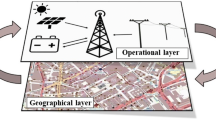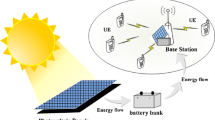Abstract
The quest for a green renewable energy source in replacement of conventional energy such as fossil fuel, diesel generator, or electric grid has taken important aspects in industrial sectors to alleviate their economy and comply with global warming reduction. In the information and telecommunication (IT) sector, base stations generate more than 90% of energy used in a network. Green energy from photovoltaic (PV) systems can be used to tackle base station energy consumption, however, non-exhaustive analyses are required to meet the demand while kee** the cost of energy production at minimum. Therefore, how can PV systems alleviate the cost of conventional energy usage while meeting the load demand for LTE base station’s equipment. This paper presents a sizing and optimization solution for a stand-alone PV (SAPV) system. A stochastic method based on an iterative numerical algorithm is used to define the size of the PV, meanwhile, the optimum size is chosen from the lowest loss of energy supply probability (LLP) percentage and the least cost of energy (LCE). The outputs demonstrate from an LLP of 1%, the LCE is 0,305 $/kWh using 13 PV panels and 408750 Wh of battery capacity over a duration of 25 years.
Access this chapter
Tax calculation will be finalised at checkout
Purchases are for personal use only
Similar content being viewed by others
References
Camps X, Velasco G, de la Hoz J, Martín H (2015) Contribution to the PV-to-inverter sizing ratio determination using a custom flexible experimental setup. Appl Energy 149:35–45
Ratshomo K, Nembahe R (2018) South African energy sector report. Department of Energy South Africa
Antonanzas J, Osorio N, Escobar R, Urraca R, Martinez-de-Pison FJ, Antonanzas-Torres F (2016) Review of photovoltaic power forecasting. Sol Energy 136:78–111
Lamour C (2008) Energy consumption of mobile networks. The Base station e-newsletter, pp 1–5
Lange C, Kosiankowski D, Gerlach C, Westphal F-J, Gladisch A (2009) Energy consumption of telecommunication networks. In: 2009 35th European conference on optical communication, pp 1–2
Khatib T, Elmenreich W (2016) Modeling of photovoltaic systems using Matlab: simplified green codes. John Wiley & Sons
Emmanuel BO, Owolawi PA, Srivastava VM (2017) Hybrid power systems for GSM and 4G base stations in South Africa. IEEE AFRICON 2017:1003–1008
Nordin ND, Rahman HA (2015) An optimization method for designing stand alone photovoltaic system using iterative method. IEEE international conference on smart energy grid engineering (SEGE) 2015:1–6
Alsadi S, Khatib T (2018) Photovoltaic power systems optimization research status: a review of criteria, constrains, models, techniques, and software tools. Appl Sci 8:1761
Radhi MH, Mahdi E, Mftwol A (2019) Design and performance analysis of solar PV system size 2.56 kWp. In: 2019 4th scientific international conference Najaf (SICN), pp 70–73
Kamble R, Karve MGM. Optimal sizing of a grid independent standalone photovoltaic system with battery energy storage
Ibrahim IA, Khatib T, Mohamed A (2017) Optimal sizing of a standalone photovoltaic system for remote housing electrification using numerical algorithm and improved system models. Energy 126:392–403
El Shenawy E, Hegazy A, Abdellatef M (2017) Design and optimization of stand-alone PV system for Egyptian rural communities. Int J Appl Eng Res 12:10433–10446
Sumathi S, Kumar LA, Surekha P (2015) Wind energy conversion systems. In: Solar PV and wind energy conversion systems. Springer, pp 247–307
Okoye CO, Solyalı O (2017) Optimal sizing of stand-alone photovoltaic systems in residential buildings. Energy 126:573–584
Fehske A, Fettweis G, Malmodin J, Biczok G (2011) The global footprint of mobile communications: The ecological and economic perspective. IEEE Commun Mag 49:55–62
Liu K, He J, Ding J, Zhu Y, Liu Z (2013) Base station power model and application for energy efficient LTE. In: 2013 15th IEEE international conference on communication technology, pp 86–92
Auer G, Giannini V, Desset C, Godor I, Skillermark P, Olsson M et al (2011) How much energy is needed to run a wireless network? IEEE Wirel Commun 18:40–49
Naicker K (2018) Investigating the operations and maintenance strategy of solar photovoltaic plants in South Africa. North-West University
Alexander M (2021) Map** poverty in South Africa. https://southafrica-info.com/people/map**-poverty-in-south-africa/
Valev N (2021). https://www.theglobalpetrolprices.com
Moolman S (2021) 2021 update: Eskom tariff increases vs inflation since 1988 (with projections to 2023). https://poweroptimal.com/2021-update-eskom-tariff-increases-vs-inflation-since-1988/
Author information
Authors and Affiliations
Corresponding author
Editor information
Editors and Affiliations
Rights and permissions
Copyright information
© 2023 The Author(s), under exclusive license to Springer Nature Singapore Pte Ltd.
About this paper
Cite this paper
Ondo-Ekogha, E., Owolawi, P.A. (2023). SAPV Sizing Optimization: A Numerical Iterative Method Using LTE Base Station Profile in SA. In: Pandit, M., Gaur, M.K., Kumar, S. (eds) Artificial Intelligence and Sustainable Computing. ICSISCET 2022. Algorithms for Intelligent Systems. Springer, Singapore. https://doi.org/10.1007/978-981-99-1431-9_55
Download citation
DOI: https://doi.org/10.1007/978-981-99-1431-9_55
Published:
Publisher Name: Springer, Singapore
Print ISBN: 978-981-99-1430-2
Online ISBN: 978-981-99-1431-9
eBook Packages: Intelligent Technologies and RoboticsIntelligent Technologies and Robotics (R0)




